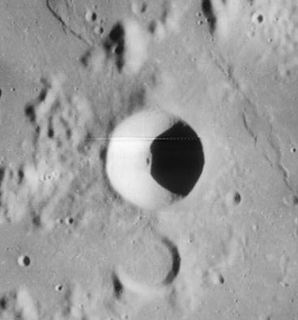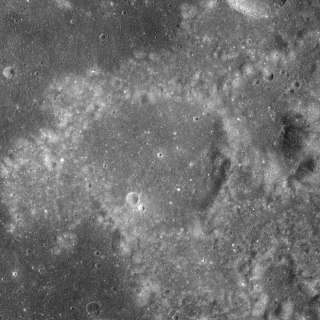
Schickard is a lunar impact crater of the form called a walled plain. It lies in the southwest sector of the Moon, near the lunar limb. As a result, the crater appears oblong due to foreshortening. Attached to the northern rim is the lesser crater Lehmann, and to the northeast is the even smaller Drebbel. Southwest of Schickard is Wargentin, a lava-flooded plateau.

Chladni is a small lunar impact crater that lies near the northwest edge of Sinus Medii, in the central part of the Moon. The crater is named for German physicist and musician Ernst Chladni who, in 1794, wrote the first book on meteorites. The rim of the crater is roughly circular, and there is a small central floor at the midpoint of the sloping inner walls. This feature has a higher albedo than the surrounding terrain. It is connected by a low ridge to the rim of the crater Murchison, which lies to the northwest. Due east of Chladni is the larger Triesnecker.

Abel is an ancient lunar impact crater that lies near the southeast limb of the Moon's near side. It is located to the south of the crater Barnard, at the northwest edge of the Mare Australe.

Artamonov is a lunar impact crater that is located on the far side of the Moon. The eroded outer rim of Artamonov does not have the circular shape of most lunar craters, and instead has the overall shape of three or four merged craters. The largest of these formations is in the south, with smaller circular bulges to the north and east.

Hess is a lunar impact crater that lies in the southern hemisphere on the far side of the Moon. The crater rim has been worn by subsequent impacts, leaving a low, eroded outer wall. The flat interior has been resurfaced by lava flows and is free of significant impacts. This floor has a slightly darker albedo than the surrounding terrain.

Joliot is a large lunar impact crater that lies on the far side of the Moon, just past the eastern limb. At this location it lies in a region of the surface that comes into sight during a favorable libration, although at such times it is viewed from the side. Thus viewing this crater in detail must be done from orbit.

Chamberlin is a lunar impact crater that is located on the far side of the Moon, just past the southeastern limb. It lies to the southeast of the crater Jeans, and Moulton is attached to the southeastern rim of Chamberlin. This crater is located in a part of the lunar surface that has undergone resurfacing of crater interiors, producing dark-hued crater floors.

Lyell is a lunar impact crater that lies along the eastern edge of the Mare Tranquillitatis, at the northern arm of the bay designated Sinus Concordiae. It was named after Scottish geologist Charles Lyell. To the north along the edge of the lunar mare is the crater Franz. The region of terrain to the east of Lyell is named Palus Somni.

Darney is a small lunar impact crater that is located on the region of the Moon where the Mare Nubium joins the Oceanus Procellarum. It was named after French astronomer Maurice Darney. To the south is the lava-flooded crater Lubiniezky. The southern rim of Darney is attached to a series of low ridges that extend to the southwest.

Condorcet is a lunar impact crater that is located in the eastern part of the Moon's near side, to the southeast of the Mare Crisium. It was named after French mathematician Marquis de Condorcet. To the northeast of Condorcet are the craters Hansen and Alhazen.

Bolyai is an old lunar impact crater that is located in the southern hemisphere on the far side of the Moon. To the southeast of Bolyai is the crater Eötvös, and to the north is Neujmin. It is named after the 19th century Hungarian mathematician János Bolyai.

Cannon is a lunar impact crater that is located near the east-northeastern limb of the Moon's near side. It lies just to the northwest of the Mare Marginis, and south-southeast of the crater Plutarch. Farther to the east-northeast is Hubble.

Cayley is a small lunar impact crater that is located in a lava-flooded region to the west of Mare Tranquillitatis. It was named after the 19th century British mathematician Arthur Cayley. It lies to the northwest of the smaller crater De Morgan and the larger D'Arrest. West and slightly north of Cayley is Whewell, a crater of about the same dimensions. To the north is a linear rille designated Rima Ariadaeus, which follows a course to the east-southeast.

Campbell is a large lunar impact crater that is located in the northern hemisphere on the far side of the Moon. It lies to the southwest of the walled plain D'Alembert, an even larger formation. If Campbell were located on the near side of the Moon as seen from the Earth, it would form one of the largest visible craters, being slightly larger than Schickard. It is bordered by several craters of note, with Wiener to the southwest, Von Neumann just to the south, Ley overlying the southeast rim, and Pawsey to the west.

Chevallier is a lunar impact crater that is located in the northeastern part of the Moon's near side, about a crater diameter east-southeast of the prominent crater Atlas. To the south-southeast of Chevallier is the flooded crater Shuckburgh.

Schwabe is a small lunar impact crater that is located in the northern part of the Moon. It ies to the southeast of the much larger crater Arnold, and east-northeast of Democritus.

Schumacher is a lunar impact crater that lies in the northeast part of the Moon, just to the north of the larger walled plain Messala. The two formations are separated by a rough strip of terrain less than 10 kilometers across, and bisected by a pair of small, co-joined craters. The northern member of this pair lies across the southern rim of Schumacher, and intrudes into the interior floor.

File: Franz is a small lunar impact crater identified during the Apollo mission in August 1971 and located along the eastern edge of the Sinus Amoris, a bay that forms a northern extension to the Mare Tranquillitatis. Its diameter is 25 km. It was named after German astronomer Julius Heinrich Franz. It lies to the southwest of the prominent crater Macrobius. To the north is the smaller Carmichael, and to the northwest is the diminutive Theophrastus.

Hubble is a lunar impact crater that lies very near the east-northeastern limb of the Moon. At this location it is viewed almost from the side from Earth, and the visibility of this feature is affected by libration. It lies to the north of the Mare Marginis and northeast of the crater Cannon. About one crater diameter to the north-northeast is Lyapunov.

Pauli is a lunar impact crater that is located on the Moon's far side. It lies about halfway between the lunar equator and southern pole, across the southern rim of the larger walled plain Roche.





























